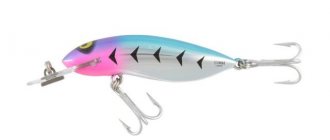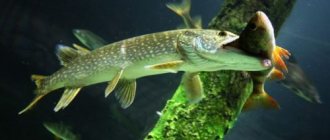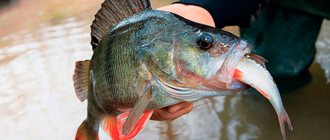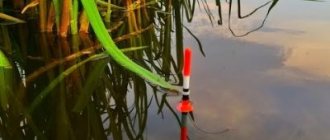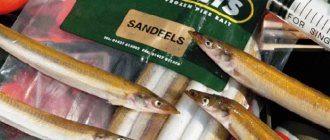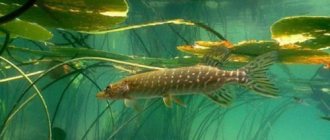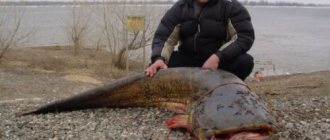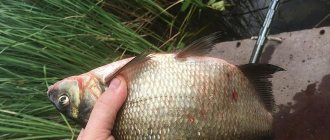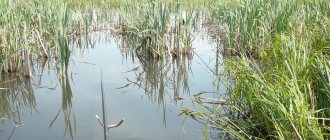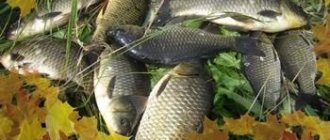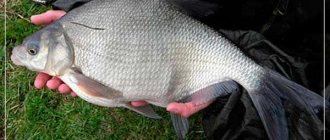Pike is one of the most cunning and insatiable predators living in fresh water. Although science distinguishes more than five species living on the Eurasian continent, most fishermen are sure that there are only two subspecies of this predator:
- Grass pike – weighing up to 2 kg, which is most often caught near coastal thickets (in thickets of aquatic vegetation);
- Deep pike - weighing over 2 kg, which supposedly lives only at great depths and rarely appears near the shore;
In reality, they are the same species. It’s just that initially small pike (just like perch) live in places where they can find food and shelter from a larger predator - in coastal vegetation.
Having reached a weight of about 2 kg, it goes to depth. In new conditions, this fish hunts mainly from ambush (from a hole, from behind stones or snags). The fish becomes less active, but smart and calculating. Pike are almost always sure to attack.
Pike is a solitary fish. This predator gathers in schools only during the spawning period. Each predator controls a certain area of the reservoir. But the place of the caught fish is quickly taken by another predator.
You can catch in various ways. During the open water season, the most effective ways to catch this fish are:
- Spinning (artificial bait such as spinnerbait).
- Fly fishing (artificial bait).
- Float tackle (live bait).
- Mugs and girders (live bait).
The most effective, although not the most sporting way of catching pike during the open water period is considered to be fishing using float gear.
Decent trophy
Selection of gear
The most important thing is to choose a good rod and a reliable reel, you might even catch a big pike! Let's look at each element separately.
Variety of rod selection
Rod
Any rod equipped with guides and a reel seat will do. Priority: Bolognese or matcha.
The rod must be durable, made of composite materials or modified carbon. The length must be chosen based on the casting distance. The farther you have to cast the bait, the longer the rod should be. When choosing a fishing rod, you don’t have to pay much attention to its structure, but the test is an important indicator. The rod test should be between 40 and 100 grams.
Spinning instead of a fishing rod for fishing with a float is also suitable
Coil
Bolognese and match fishing rods are usually equipped with specialized spinning reels, marked in the markings as “BOLO” and “MATCH”. But it is not necessary to purchase reels with exactly this marking. Just pay attention to the characteristics of the coil.
For pike fishing with a float, it is best to choose a reel size from 2500 to 3500 with a front friction brake, the ability to instantly turn it on and fine adjustment. The number of bearings is not an indicator, but it is better if the winding mechanism has at least 3 metal bearings and one roller.
It’s good if the reel is light, but fishing with a float is usually passive, the fishing rod lies on a stand, so the weight of the reel does not play a special role. It’s not bad if the spool holds at least 100 meters of fishing line with a cross-section of 0.22 mm. A spare spool, equipped with a different type of fishing line or fishing line of a different section, will also be a big plus for such gear.
Spinning reel for float tackle
fishing line
As the main fishing line, either nylon monofilament or braid is most often used.
Nylon monofilament is more versatile, less noticeable, and stretchable. Therefore, in spring and autumn it is indispensable in the equipment of a float fishing rod.
Braid has exceptional strength, which is important when fishing in heavily overgrown reservoirs, as well as in places where you can find a lot of snags at the bottom. However, it is too noticeable in clear water, so it can only be used in summer and only in reservoirs where there is a lot of algae.
The cross-section of the fishing line should be selected taking into account the size of the fish living in the pond. Theoretically, a 0.18 mm fishing line can be used to catch a grass species, but it is best to use a soft fishing line with a cross-section of at least 0.22 mm.
Leashes
Some fishermen use metal leashes in float rigs for pike. This is quite applicable in conditions of muddy water, in the spring, when it fattens after the winter “fast.” In summer and autumn, this durable, but highly noticeable leash in the water can be safely replaced with a leash made of a less noticeable material: fluorocarbon or cauller.
Typically, in reservoirs without a current, leashes with a length of 15 to 25 cm can be used.
On bodies of water with current, the length of the leash needs to be increased. Leashes of 30 – 50 cm are quite suitable for equipping a float rod on rivers and canals with current.
Hooks
In float equipment, either single or double hooks are usually used, which cause less harm to live bait when hooked. You can experiment with the size of the hook, matching it to the size of the bait. The hook must be strong (pike is a fairly strong predator) and sharp (pike has a strong jaw, it is quite difficult to penetrate it enough during hooking). It is best that it does not shine too much in the sun.
Double hook
Float for pike
The float must be heavy enough so that live bait cannot submerge it on its own. Therefore, the ideal float weight is 5-8 grams.
The body of the float should be spherical, oval or olive-shaped. The float keel can be:
- long (for fishing on the river;
- short (for fishing in reservoirs without current).
A float with a long keel can be used on reservoirs without current in windy weather.
Simple floats
There is only one requirement for the float antenna - it must be clearly visible. The length of the antenna in this fishing method does not matter, but usually it does not exceed 5 cm (cross-section up to 5 mm.) The color of the antenna is bright red, orange or crimson. Floats for the current.
It is better for a beginner to buy such a float for the first time. But in principle, making it from scrap materials is not difficult.
DIY floats for pike fishing
Sinker
As a sinker in tackle, sliding sinkers in the shape of an olive made of lead or tungsten are most often used. The weight of the sinker is selected in accordance with the weight and carrying capacity of the float.
How to put live bait on a hook
It is very important to mount your live bait correctly. If it is placed incorrectly, it will either quickly fall asleep, or will be of least interest to the pike and it will ignore it, even if you throw it right under its nose. Let's look at several ways to hook live bait and identify all the mistakes so you can avoid them.
Behind the dorsal fin . The most common and universal method, but very often fishermen make mistakes when using it. Remember, when baiting, it is very important not to catch the ridge of the fish, which runs approximately in the middle of the body, otherwise the bait will instantly become unusable and will not move.
One more point - the live bait should be placed behind the back so that its head is tilted down, then it will imitate a fish that is looking for food. It is the fish's head down, at approximately an angle of 30-45 degrees, that is its natural position. If you shift the center of gravity so that the fisherman is held straight or even head up, then the number of bites may be noticeably reduced. In the photo you can see the incorrect use of the center of gravity and the fish’s head is raised up.
By the chin. I don’t know if the fish has a beard, but it doesn’t matter, let’s call this method “By the chin.” This method is used when fishing in the current. That is, if you fish on a river, then this method is better. You need to insert the tip of the hook under the fish's chin and out through its nostril. During the current, the fish will behave very naturally and attract a predator very well.
But this method is best used when fishing with small live bait, otherwise there may be a lot of idle bites just because the hook will be located at the very edge of the bait, and the pike always grabs the fish approximately in the middle, across its body. Or you can use two doubles - one clings to the chin, and the second to the side of the fish, the main thing is not to damage the ridge.
Through the gills . The good thing about this method is that it minimizes injuries to the live bait, or rather, it will not get injured at all, because you won’t have to pierce the body. Therefore, this method is good for live bait, which very quickly become dead. You need to unfasten the double from the leader, insert this leader through the operculum of the fish, bring it out through the mouth and reattach the hook to the leader. Pull the leash a little to fix the double in the fish’s mouth and the installation is ready. After the bite, do not rush to hook - give the pike 10-15 seconds so that it swallows the bait well.
Video: how to properly place live bait on a hook
And, by the way, using a double is the most optimal way. A single hook leads to a lot of idle bites, and a tee often alerts the predator or she, having pricked herself, throws the victim out of her mouth. The double in this sense is the golden mean and copes with its task perfectly.
This is where the site ryba4ok.ru ends its story about catching pike with live bait. I hope everything is clear to you and the information was really useful. Leave your comments and no tail, no scales.
Promising places for catching pike on a float
Throughout the year, pike constantly change their camp sites. Therefore, you will have to look for it during the open water season in different parts of the reservoir.
Spring. From the moment when... Spring fish should be looked for in places where potential food accumulates: fry and concentrations of small fish.
Such places include:
- Places where small shallow rivers and streams flow into a body of water;
- Small areas of reservoirs (regardless of the strength of the current);
- Behind the rifts in shallow water;
The main condition is the presence of fry in those places.
Summer
During this period, grass pike moves to grass thickets, where it hunts from ambush, hiding in dense thickets, near snags, flooded bushes, and near stones.
At this time, the deep one stands in holes, near rapids, behind rifts, stays in the deepest places and most often goes out hunting at dusk.
Waiting for the victim
Autumn
During this period, it can be found almost throughout the reservoir, regardless of the size of the fish. She is preparing for winter.
Closer to cold weather, it moves closer to the pits, where the water still retains heat. Hunts there until the cold weather. Then its activity drops until the first ice, when it is time to switch to winter gear.
Technique for catching pike with a float
After a place has been chosen, a fishing rod has been equipped, the bait has been attached, you need to make an accurate, careful cast. Live bait is a delicate bait. A force throw from behind is not an option. The best casting method is pendulum. Quite often the bite follows at the moment of casting. If this does not happen, you will have to wait. Occasionally, you can pull the bait a few centimeters to the shore.
Usually, at the moment of a bite, he takes the bait sharply. The float moves to the side a meter or a little more and stops. At this moment, the predator that has captured the bait intercepts it in its mouth to swallow it. As soon as the float begins to move, after a pause you can count.
You need to hook with a short amplitude but strong jerk. The task is to pierce the hard jaw or larynx of the predator with a sting. It depends on your luck.
According to science, the faster you reel the fish in, the better. The pike resists desperately. It will try to tangle the fishing line in the snag. Close to the shore, he uses his signature technique - candles (jumps out of the water with his mouth open, shaking his head from side to side). With a small one there is no need to stand on ceremony. It needs to be quickly pulled to the shore and taken either in a net or under the gills.
With a large one it is more difficult, because this fish is not only strong, but also smart. But you also need to reel it out, trying not to weaken the line.
If you decide to keep the trophy as a catch, then you can keep it in a separate cage, or put it on a kukan.
Approximately 1 kg
The most ancient version of the float
Feather floats have been used since ancient times. This is the most sensitive type of float due to its lightness and shape. They can record even light touches of fish.
To make this float you will need geese or duck feathers and a little time.
- The feather needs to be cleared of the fan; only the bare rod is needed - it will be the body of the float.
The fan must not be torn off by hand. It is recommended to cut it with a razor or knife against the direction of growth. Otherwise, water will get into the barely noticeable holes and the float will lose its buoyancy.
- After trimming, you need to singe the rod and remove the smallest fibers.
- Then paint the thick end of the feather with bright paint.
- All that remains is to put two rubber nipple rings on the feather for fastening to the fishing line.
- Ready!
Making a float with your own hands is not difficult. The main thing is that it has the necessary properties: water-resistant, moisture-resistant, durable, brightly colored and made from cheap materials. Otherwise there will be no point in making it.
Author's tips:
- Choose the most common fish in this particular body of water as bait. The best thing is to try to catch it with a light float tackle or a small fish directly on the pond.
- Experiment with bait. For example, exchange crucian carp for gudgeon or small roach. Guessing what's on a predator's mind is extremely difficult;
- Change the elements of the equipment, especially leads and hooks, to thinner or less noticeable ones as you go fishing.
- Watch. The best way to determine the behavior of pike is through observation.
- Don't be greedy. Release small predators back into the pond. And then, in a few years, every fishermen will have the opportunity to enjoy fighting with a real trophy pike.

